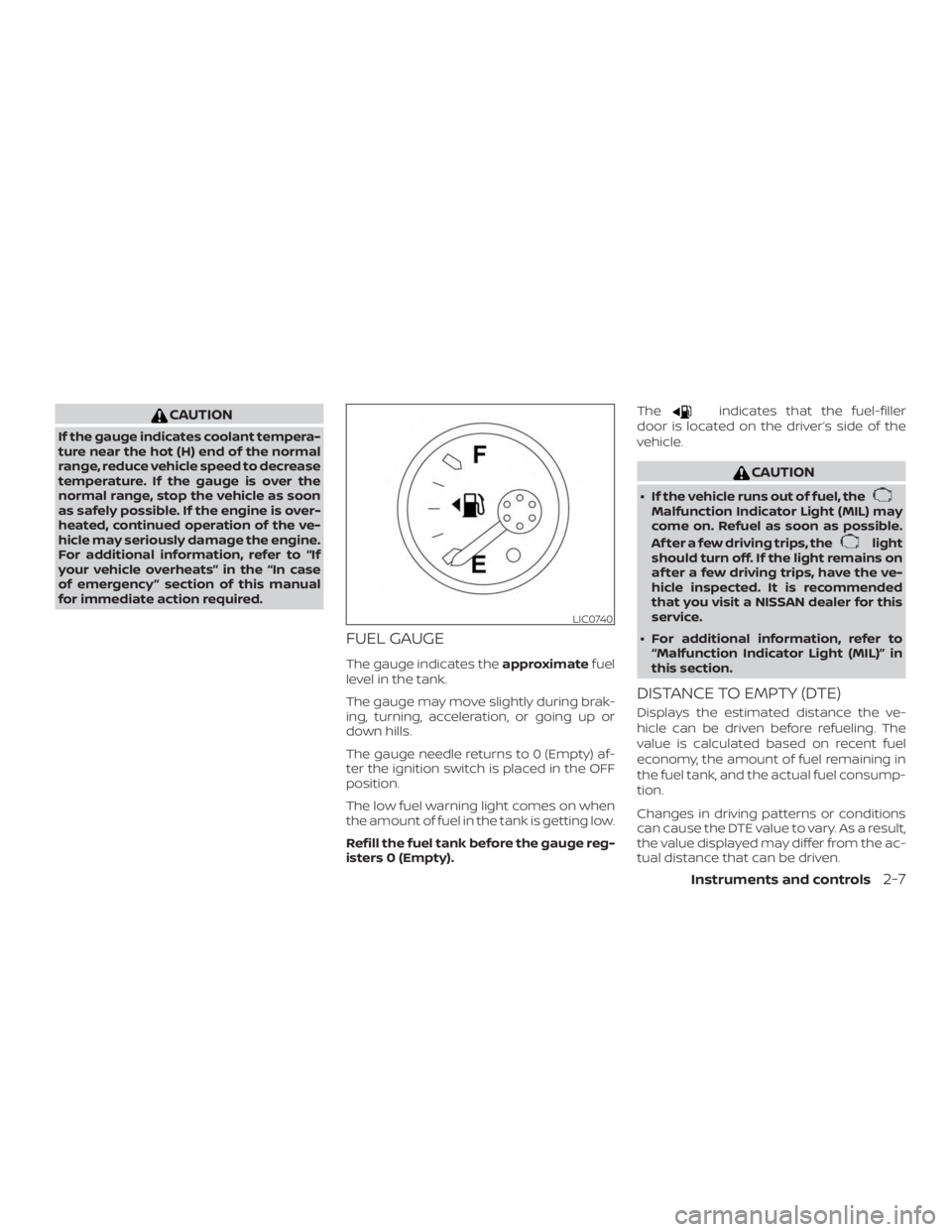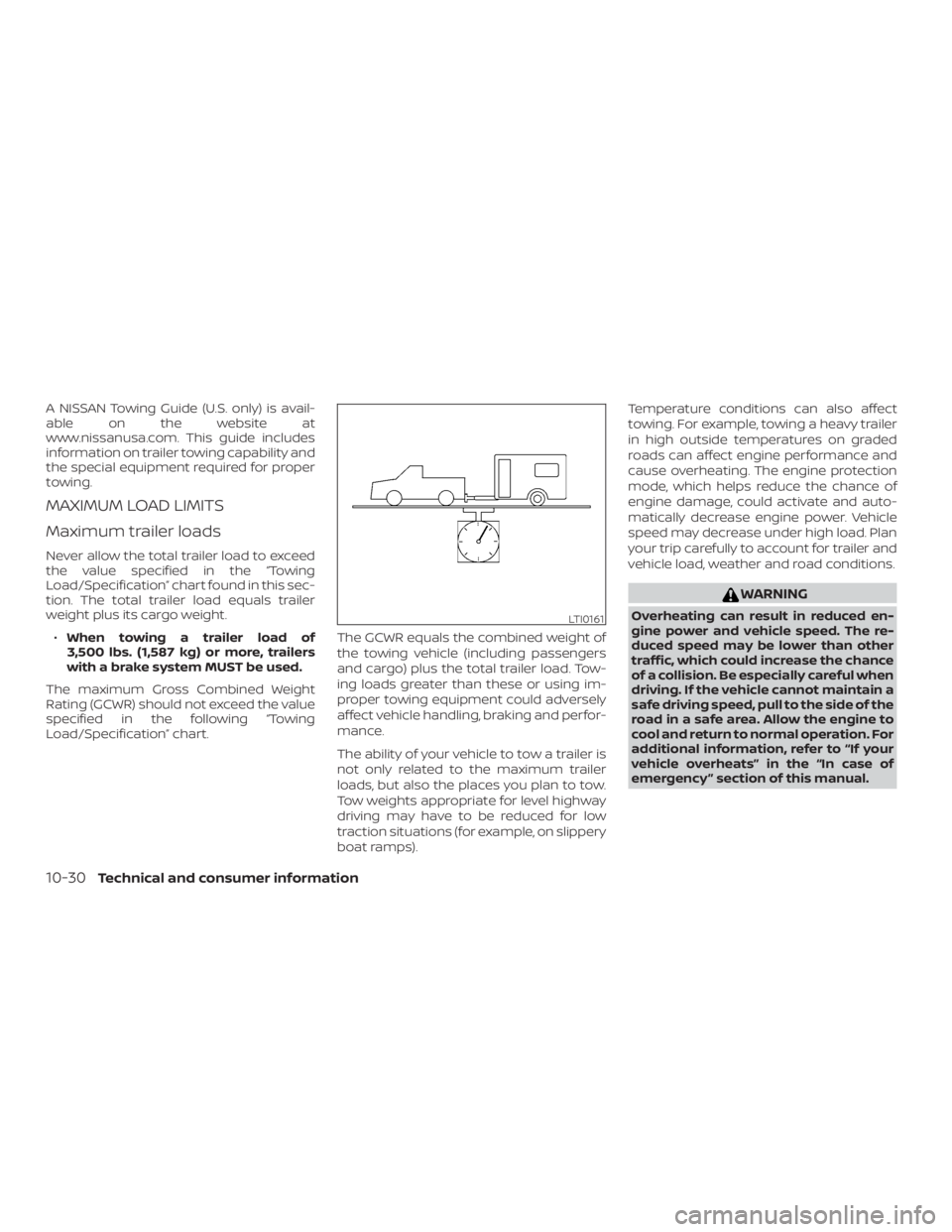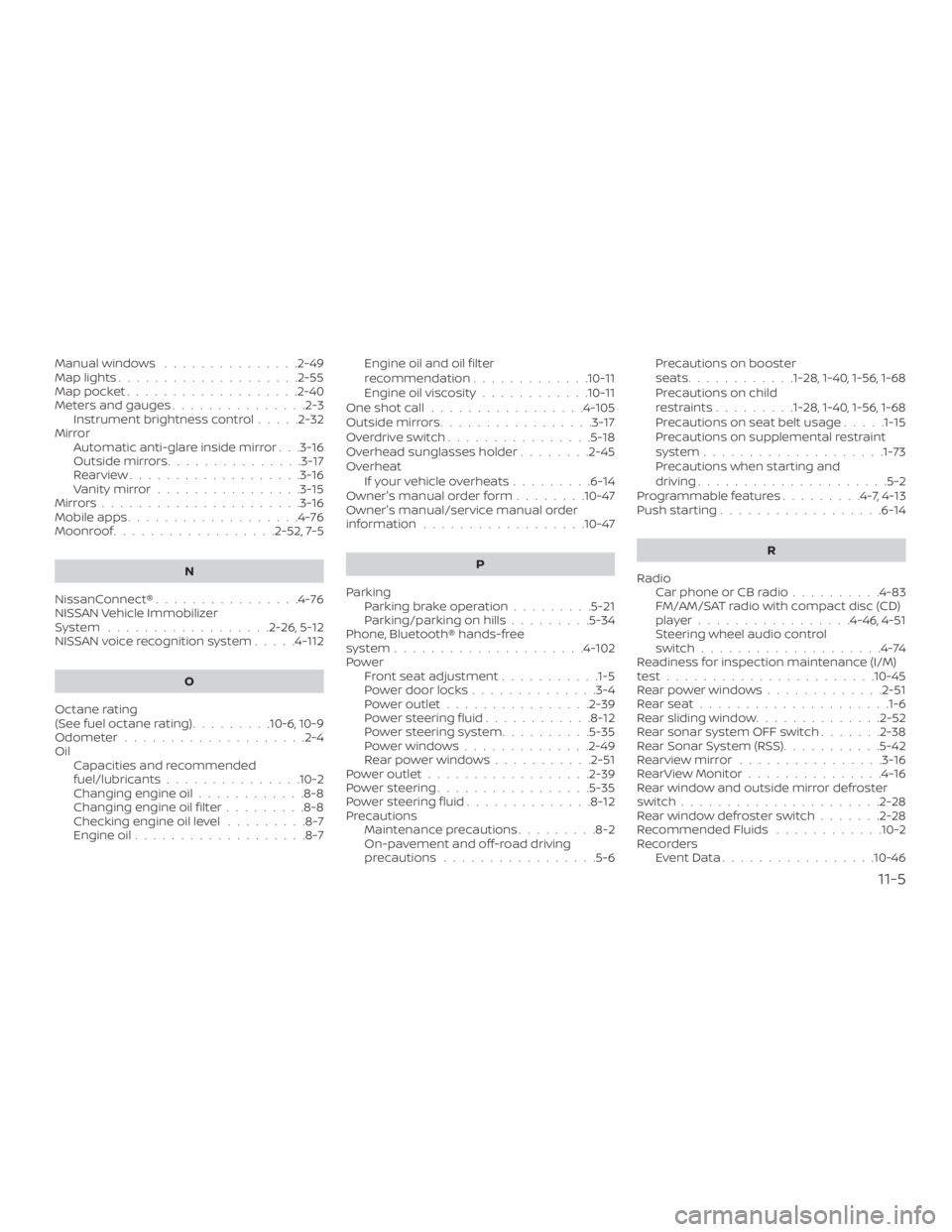2019 NISSAN FRONTIER PRO-4X engine overheat
[x] Cancel search: engine overheatPage 121 of 516

CAUTION
If the gauge indicates coolant tempera-
ture near the hot (H) end of the normal
range, reduce vehicle speed to decrease
temperature. If the gauge is over the
normal range, stop the vehicle as soon
as safely possible. If the engine is over-
heated, continued operation of the ve-
hicle may seriously damage the engine.
For additional information, refer to “If
your vehicle overheats” in the “In case
of emergency ” section of this manual
for immediate action required.
FUEL GAUGE
The gauge indicates theapproximatefuel
level in the tank.
The gauge may move slightly during brak-
ing, turning, acceleration, or going up or
down hills.
The gauge needle returns to 0 (Empty) af-
ter the ignition switch is placed in the OFF
position.
The low fuel warning light comes on when
the amount of fuel in the tank is getting low.
Refill the fuel tank before the gauge reg-
isters 0 (Empty). The
Page 154 of 516

∙ Do not use double adapters or morethan one electrical accessory.
∙ Use power outlets with the engine running to avoid discharging the ve-
hicle battery.
∙ Avoid using power outlets when the air conditioner, headlights or rear win-
dow defroster is on.
∙ Before inserting or disconnecting a plug, be sure the electrical accessory
being used is turned off.
∙ Push the plug in as far as it will go. If good contact is not made, the plug
may overheat or the internal tem-
perature fuse may open.
∙ When not in use, be sure to close the cap. Do not allow water or any other
liquids to contact the outlet.
FRONT-DOOR POCKETS REAR-DOOR POCKETS
Page 461 of 516

Af termarket fuel additives
NISSAN does not recommend the use of
any af termarket fuel additives (for ex-
ample, fuel injector cleaner, octane
booster, intake valve deposit removers,
etc.) which are sold commercially. Many of
these additives intended for gum, varnish
or deposit removal may contain active sol-
vents or similar ingredients that can be
harmful to the fuel system and engine.
Octane rating tips
Using unleaded gasoline with an octane
rating lower than recommended can
cause persistent, heavy “spark knock.”
(“Spark knock” is a metallic rapping
noise.) If severe, this can lead to engine
damage. If you detect a persistent heavy
spark knock even when using gasoline
of the stated octane rating, or if you hear
steady spark knock while holding a
steady speed on level roads, have a
NISSAN dealer correct the condition. Fail-
ure to correct the condition is misuse of
the vehicle, for which NISSAN is not re-
sponsible.Incorrect ignition timing may result in
spark knock, af ter-run and/or overheating,
which may cause excessive fuel consump-
tion or engine damage. If any of the above
symptoms are encountered, have your ve-
hicle checked. It is recommended that you
visit a NISSAN dealer for servicing.
However, now and then you may notice
light spark knock for a short time while
accelerating or driving up hills. This is not
a cause for concern, because you get the
greatest fuel benefit when there is light
spark knock for a short time under heavy
engine load.
FLEXIBLE FUEL VEHICLE (FFV) FUEL
RECOMMENDATION (if so
equipped)
Your vehicle is designed to use (E-85) Fuel
Ethanol, “Regular” unleaded regular gaso-
line or any percentage of the two fuels
combined.
U.S. government regulations require Fuel
Ethanol dispensing pumps to have a
small, square, orange and black label
with the common abbreviation or the
appropriate percentage for that region.
Page 482 of 516

A NISSAN Towing Guide (U.S. only) is avail-
able on the website at
www.nissanusa.com. This guide includes
information on trailer towing capability and
the special equipment required for proper
towing.
MAXIMUM LOAD LIMITS
Maximum trailer loads
Never allow the total trailer load to exceed
the value specified in the “Towing
Load/Specification” chart found in this sec-
tion. The total trailer load equals trailer
weight plus its cargo weight.∙ When towing a trailer load of
3,500 lbs. (1,587 kg) or more, trailers
with a brake system MUST be used.
The maximum Gross Combined Weight
Rating (GCWR) should not exceed the value
specified in the following “Towing
Load/Specification” chart. The GCWR equals the combined weight of
the towing vehicle (including passengers
and cargo) plus the total trailer load. Tow-
ing loads greater than these or using im-
proper towing equipment could adversely
affect vehicle handling, braking and perfor-
mance.
The ability of your vehicle to tow a trailer is
not only related to the maximum trailer
loads, but also the places you plan to tow.
Tow weights appropriate for level highway
driving may have to be reduced for low
traction situations (for example, on slippery
boat ramps).Temperature conditions can also affect
towing. For example, towing a heavy trailer
in high outside temperatures on graded
roads can affect engine performance and
cause overheating. The engine protection
mode, which helps reduce the chance of
engine damage, could activate and auto-
matically decrease engine power. Vehicle
speed may decrease under high load. Plan
your trip carefully to account for trailer and
vehicle load, weather and road conditions.
Page 505 of 516

Manual windows...............2-49
Maplights....................2-55
Map pocket ...................2-40
Meters and gauges ...............2-3
Instrument brightness control .....2-32
Mirror Automatic anti-glare inside mirror . . .3-16
Outsidemirrors...............3-17
Rearview...................3-16
Vanitymirror................3-15
Mirrors......................3-16
Mobile apps ...................4-76
Moonroof ..................2-52,7-5
N
NissanConnect® ................4-76
NISSAN Vehicle Immobilizer
System ..................2-26,5-12
NISSAN voice recognition system .....4-112
O
Octane rating
(Seefueloctanerating).........10-6,10-9
Odometer ....................2-4
Oil Capacities and recommended
fuel/lubricants...............10-2
Changing engine oil ............8-8
Changing engine oil filter .........8-8
Checking engine oil level .........8-7
Engine oil ...................8-7 Engine oil and oil filter
recommendation
.............10-11
Engine oil viscosity ............10-11
One shot call .................4-105
Outsidemirrors.................3-17
Overdriveswitch................5-18
Overhead sunglasses holder ........2-45
Overheat Ifyourvehicleoverheats.........6-14
Owner's manual order form ........10-47
Owner's manual/service manual order
information..................10-47
P
Parking Parking brake operation .........5-21
Parking/parkingonhills.........5-34
Phone, Bluetooth® hands-free
system .....................4-102
Power Front seat adjustment ...........1-5
Power door locks ..............3-4
Poweroutlet................2-39
Powersteeringfluid............8-12
Power steering system ..........5-35
Powerwindows..............2-49
Rearpowerwindows...........2-51
Poweroutlet..................2-39
Powersteering.................5-35
Powersteeringfluid..............8-12
Precautions Maintenance precautions .........8-2
On-pavement and off-road driving
precautions .................5-6 Precautions on booster
seats............1-28, 1-40, 1-56, 1-68
Precautions on child
restraints.........1-28, 1-40, 1-56, 1-68
Precautionsonseatbeltusage.....1-15
Precautions on supplemental restraint
system
....................1-73
Precautions when starting and
driving .....................5-2
Programmable features .........4-7,4-13
Push starting ..................6-14
R
Radio Car phone or CB radio ..........4-83
FM/AM/SAT radio with compact disc (CD)
player.................4-46,4-51
Steering wheel audio control
switch....................4-74
Readiness for inspection maintenance (I/M)
test.......................10-45
Rearpowerwindows............ .2-51
Rearseat.....................1-6
Rearslidingwindow..............2-52
Rear sonar system OFF switch .......2-38
Rear Sonar System (RSS) ...........5-42
Rearviewmirror ................3-16
RearViewMonitor...............4-16
Rear window and outside mirror defroster
switch......................2-28
Rearwindowdefrosterswitch.......2-28
Recommended Fluids ............
1
0-2
Recorders EventData.................10-46
11-5